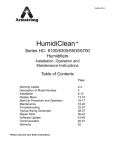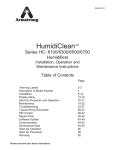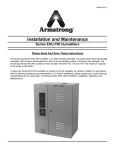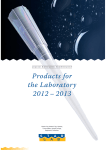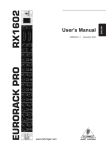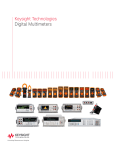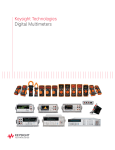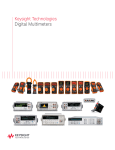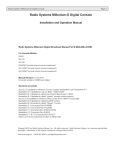Download Armstrong EHU-700 Series Troubleshooting guide
Transcript
Bulletin No. 560-G ® Installation and Operation HumidiPack ,® HumidiPack CF, and HumidiPackPlus™ Complete Packaged Humidifier Systems Table of Contents Preliminary Procedures ................................................................................................................................................. 2 Do’s & Don’ts of Location and Installation ..................................................................................................................... 3 Installation ...................................................................................................................................................................... 4 Typical Duct Installations ............................................................................................................................................... 5 Installation Concepts ..................................................................................................................................................... 6 Auxiliary Controls ........................................................................................................................................................... 9 Troubleshooting Guide ................................................................................................................................................. 11 Limited Warranty and Remedy ..................................................................................................................................... 12 Preliminary Procedures These instructions cover the installation of the HumidiPack® and HumidiPackPlus with the Armstrong ACV Control Valve (models listed below). The HumidiPack and HumidiPackPlus represent complete packaged humidification systems when used in conjunction with existing boiler steam. HumidiPack may also be used for distribution of steam generated by electric or steam-to-steam humidifiers (steam generating). In these instances, no strainer, control valve, or steam traps are supplied. When used with boiler steam, the systems come with the following equipment: HumidiPack Contents: • HumidiPack Panel • Armstrong Inverted Bucket Steam Trap (to be used to drip steam supply to control valve) • Armstrong ACV Control Valve • Armstrong In-Line Y Strainer (to be used prior to the control valve) • Armstrong Float & Thermostatic Steam Trap (for condensate drainage of HumidiPack header) (two traps are needed for HumidiPack CF) HumidiPackPlus Contents: • HumidiPackPlus Panel • Armstrong Inverted Bucket Steam Trap (to be used to drip steam supply to control valve) • Armstrong ACV Control Valve • Armstrong In-Line Y Strainer (to be used prior to the control valve) • Two Armstrong Float & Thermostatic Steam Traps (one for header drainage, one for active tube jacket drainage) Step 1: Check Shipment Against Packing List. All components are listed on the packing slip. Report any shortages immediately. If the HumidiPack or accessories have been damaged in transit, notify us and file claim with the transportation company. Armstrong ACV Control Valves* Model Size Available Pneumatic Operators ACV-2 Armstrong C-1801 ACV-3 Honeywell MP-953D ACV-4 Honeywell MP-953F w/Pilot ACV-6 Positioner Model Size Available Electric Operators ACV-2 Honeywell M9182A ACV-3 Belimo ACV-4 AF24SR or NVF24 ACV-6 If your order covers more than one package, segregate each complete assembly. Equipment tagging will be the same as shown on the packing list. Model, Serial Number, Steam Pressure and Orifice Size are on the metal plate on the control valve body. Step 2: Check Local Codes. The Armstrong HumidiPack should be installed in accordance with all applicable building, plumbing, and electrical codes. *Some larger size HumidiPacks may use 2" or 2-1/2" Honeywell control valves. Step 3: Find HumidiPack Panel Location. Locate all HumidiPack equipment according to the engineer’s layout or as indicated by your Armstrong Representative. If you must locate the HumidiPack/HumidiPackPlus yourself, be sure to read and observe the “Do’s and Don'ts” to follow. Do’s & Don’ts of Location and Installation All recommendations for the application of the Armstrong HumidiPack and HumidiPackPlus are based on tests and field experience. However, they are based on duct air velocities and temperatures that are most commonly encountered, and the recommendations may have to be modified when velocities are very high and/or temperatures unusually low. We also reserve the right to modify recommendations without notice if subsequent tests or experience indicate that a change should be made. For these reasons, we urge you to check all applications with your Armstrong Representative before installation. (Illustrations applicable to both HumidiPack and HumidiPackPlus.) See Figures 3-1 through 3-7. 2 Maintain at Least Specified Vapor Trail Coil Dead Air Dead Air Filter Do Don't Don't Figure 3-1. The HumidiPack must have airflow across the entire crosssection. Avoid fan discharges without gradually transitioning the duct to the HumidiPack. Figure 3-2. The HumidiPack cannot have daead air space off the discharge side. When discharging into a fan intake plenum, allow for vapor trail length then gradually transition the duct. Figure 3-3. Coils, duct transitions and other obstructions must be kept at least the specified vapor trail length downstream from the HumidiPack. This does not apply to high efficiency filters. Consult factory on these applications. Beyond Specified Vapor Trail Less Than 8" Don't Do Figure 3-4. Eight inch clearance (Min.) should be maintained on discharge side of coils. Don't Less Than Specified Vapor Trail Duct Temp. Control Figure 3-5. If temperature controlling devices must be placed directly downstream from the HumidiPack, all visible vapor must be absorbed. This may be a longer distance than just the specified vapor trail. Consult factory if questionable applications arise. Beyond Specified Vapor Trail Less Than Specified Vapor Trail Discharge Grill Do Don't Figure 3-6. All airflow must be directed through HumidiPack. If HumidiPack is smaller than the duct cross-section, HumidiPack should be positioned in center of duct and all open area should be blocked off. This is an exception for some "all active" unit applications. Do Don't Figure 3-7. When installing the HumidiPack directly upstream from a discharge grill, the minimum distance shall be the specified vapor trail. It should be noted that visible wisps of vapor can still be seen even though the length is beyond the vapor trail. This vapor will not condense on the grill, but may be seen in the room space. 3 Installation Step 4: HumidiPack or HumidiPackPlus Panel Insertion The HumidiPack or HumidiPackPlus Panel consists of the header, inboard header plate, outboard support plate, and active/inactive tubes (See Figure 4-1). For larger units a stainless steel center tube support will be included. Holes on the inboard header plate are provided and selftapping sheet metal screws are supplied. The wall of the duct or air handler must be cut out. The inboard header plate of the tube assembly will mount to the duct wall. Figure 4-1 Plan View Control Valve From Boiler From Boiler Strainer 2" NPT Inlet 8.5" Drip Leg B (Overall Width) Duct Size Inboard Header Outboard Ensure that Plate Header Support Plate HumidiPack or Header Air Flow HumidiPackPlus panel A orientation has air flow Inactive Tubes impinging against the inactive tubes (without nozzles or #10-16 discharge orifices) first, then 1"/12" Slope Hex Head 1" Air Gap Active Tubes against the active tubes (with Screws Drain Inactive Tubes Side View nozzles or discharge orifices). Inboard Header Plate F&T Trap Both the active/inactive tubes 1" Air Gap Drain must be level or slightly sloped Elevation View F&T Trap back toward the header. They cannot be sloped downward. Certain applications may dictate the use of a custom designed system without inactive tubes. In this instance, HumidiPack/HumidiPackPlus panel orientation is such that air impinges against nozzle or discharge orifice opening. The steam initially flows against airflow and then changes direction to flow downstream. IMPORTANT: When lifting HumidiPack or HumidiPackPlus, do so by the eyehook on the header. The outboard end of the tube assembly can be supported by lifting on the inactive tubes. Do not lift by using the active tubes. The outboard support plate is secured from any lateral movement by 3/8" panel nuts and 3/8" lag bolts (See Fig. 4-1). The holes to be drilled in the far side of the duct for the lag bolts can be sometimes difficult to locate. If this is so, a threaded rod with a ground point on the end can be inserted in the panel nut. By sliding the panel through the opening, the rod will pierce the duct wall indicating a drilling position for the lag bolt. Note that the panel should slide into the duct and over any seams on the duct floor. A "leg" positioned on the lower outboard corner of the panel facilitates this. After ensuring both the inboard header plate and outboard support plate are secured, steam supply connections from the Armstrong ACV control valve to the header can be made. If the HumidiPack/HumidiPackPlus is smaller than the duct inside height and/or width the extra space should be blanked off to direct all air through panel. 4 Typical HumidiPack® Duct Installations (HumidiPackPlus orientation is similar) (HumidiPackPlus orientation is similar) Inlet Outlet Drain Figure 5-1 Horizontal Unit Right to Left Flow (Left Hand Header) Figure 5-2 Vertical Unit Left Handed Steam Inlet Inlet Outlet Drain Figure 5-3 Vertical Duct Downward Flow (Left Hand Inlet) Installation Concepts Condensate Drainage Options Condensate discharged from the HumidiPack or HumidiPackPlus separator/header is at essentially atmospheric pressure. Thus the condensate must be discharged to a drain or pumped. On many applications, an attempt to lift condensate even a few inches will lead to potential flooding or spitting problems from the multiple tube bank. For HumidiPackPlus units having a header drain connection and active tube jacket drain connection, a separate F&T steam trap must be used for each. Avoid master trapping the two connections to one steam trap. If traps discharge into a common return, install check valves (low opening pressure) on the outlet of each steam trap. 5 Strainer From Boiler Control Valve Control Valve From Boiler From Boiler Strainer Drip Leg Drip Leg Header Angle Iron Mounting Frame Header 6" - 12" Min. Active Tubes 1" Air Gap 1"/12" Slope X Drain Atmospheric Condensate Return Inactive Tubes Dispersion Manifold Inactive Tubes F&T Trap Drain F&T Trap F&T Trap X = 6" - 12" Min. Figure 6-2. Drain traps discharging to floor drain. (HumidiPackPlus shown) Figure 6-1. Header drain trap discharging to pumped return (HumidiPack shown) E D C Control Valve F Plan View From Boiler A C Overall Width Strainer Drip Leg Header Air Flow B Angle Iron Mounting Frame (overall height) Minimum 10" High Water Seal F&T Trap 1"/12" Slope 1" Air Gap Active Tubes Drain Drain Inactive Tubes F&T Trap Side View Elevation View Figure 6-3. HumidiPack CF. Drain traps discharging to floor drain. Figure 6-4. Condensate drained through piping loop seal. Make sure outlet of loop seal is below bottom of HumidiPack header. NOTE: When installing HumidiPack for use with an electric or steam-to-steam humidifier, minimize the length of piping run from the humidifier to HumidiPack. Piping should not extend longer than 20 feet and should be a generous size (at least 2"). Consult factory if longer piping is necessary. Slope piping back toward humidifier or toward a drainage point. Pipe a loop trap to an atmospheric drain at any low points in piping run. Install, at minimum, a 10" loop seal from the HumidiPack header drain connection. Figure 6-5. Dual Panel Flanged HumidiPack System. Both "P" traps drained to atmospheric drain. 2x 10" Min. 6 Step 5: Supply Steam Piping Table 7-1. Recommended Steam Main and Branch Line Drip Leg Sizing Supplying quality steam (not wet) to the HumidiPack/ HumidiPackPlus is an important component for proper operation. Care must be taken that the main supply header is dripped sufficiently as well as the runout piping to the Armstrong ACV Control Valve and HumidiPack/HumidiPackPlus header. The entire system must be designed and hooked up to prevent accumulation of condensate at any point. The following recommendations will help to ensure this. Use drip legs and traps at all low spots or natural drainage points such as: Ahead of risers; End of mains; Ahead of expansion joints or bends; Ahead of valves or regulators. Install drip legs and drain traps even where there are no natural drainage points (See Figures 7-1 thru 7-5). H Drip Leg Length Minimum M D Steam Main Size (in) Drip Leg Diameter (in) Supervised Warm-Up (in) Automatic Warm-Up (in) 1/2 3/4 1 2 3 4 6 8 10 12 14 16 18 20 24 1/2 3/4 1 2 3 4 4 4 6 6 8 8 10 10 12 10 10 10 10 10 10 10 12 15 18 21 24 27 30 36 28 28 28 28 28 28 28 28 28 28 28 28 28 30 36 On a supervised warm-up, make drip leg length at least 1½ times the diameter of the main, but never less than 10". Make drip legs on automatic warm-ups a minimum of 28" in length. For both methods, it is a good practice to use a drip leg the same diameter as the main up to 4" pipe size and at least ½ of the diameter of the main above that, but never less than 4". See Table 7-1. 10' or Less Pitch 1/2" per 1 ft. Runout oversized One pipe size or more Figure 7-1. Trap draining strainer ahead of PRV. Figure 7-2. Trap draining drip leg at riser. Distance "H" in inches ÷ 28= psi static head for forcing water through the trap. Figure 7-3. Piping for runout less than 10 ft. No trap required unless pitch back to supply header is less than ½" per ft. More Than 10' M D H Pitch 1/2" per 10 ft. Figure 7-4. Trap draining drip leg on main. Figure 7-5. Piping for runout greater than 10'. Drip leg and trap required ahead of control valve. Strainer ahead of control valve can serve as drip leg if blowdown connection runs to an inverted bucket trap. This will also minimize the strainer cleaning problem. Trap should be equipped with an internal check valve or swing check installed ahead of the trap. 7 Shown below are typical configurations depicting proper piping practices. Do not use smaller pipe sizes than what the connections are on the supplied control valve. Take steam supply from the top of supply main-never from the side or bottom. See Steam Pipe Capacities tables on Page 12. Expansion and Contraction. With average length of supply line, the dimension change from hot to cold should not exceed 2". Provide piping with (3) 90° elbows to obtain swing to take care of expansion and contraction. Steam Main Run Out Steam Main Condensate Return or Drain Run Out Armstrong Strainer Armstrong ACV Control Valve Trap To Condensate Return/Drain To HumidiPack Header Trap Dirt Leg Figure 8-1. Typical runout less than 30 feet long. Figure 8-2. Typical long runout of 30 feet or more. Steam Main 10' Minimum If More Than 10' Run Out Strainer Armstrong Strainer Condensate Return or Drain Steam Main Armstrong ACV Control Valve PRV Is Single Seated, Dead End Type Trap Strainer Blowdown Connection To Strainer Control Valve HumidiPack Header To HumidiPack Header To Control Valve HumidiPack Header Trap Dirt Leg Figure 8-3. If the supply steam to the control valve exceeds the control valve pressure rating, an Armstrong pressure reducing valve may need to be installed after the Y strainer as shown. Figure 8-4. Piping when more than one HumidiPack or HumidiPackPlus is fed from the same steam runout. Control Valve. The Armstrong control valve is installed in the steam supply line after the Y strainer and supplies steam to the header of the HumidiPack/HumidiPackPlus panel. The steam supply connection on the top of the HumidiPack/HumidiPackPlus header is either 1" NPT or 2" NPT. The control valve connection size may be different. In these cases, reduce from the 2" connection on the HumidiPack/HumidiPackPlus header down to the Armstrong control valve size by bushing the 2" HumidiPack/HumidiPackPlus connection. Piping of air supply to pneumatic control valves are discussed in Figures 9-1, 9-2 and 9-3 while wiring for electric control vales is discussed in Figure 10-1. For more installation information of Armstrong Control Valves, see Installation Bulletin IB-58. Step 6: Install Armstrong Float & Thermostatic Steam Trap(s) a) HumidiPack The connection on the bottom of the HumidiPack header is for condensate drainage. The supplied Armstrong Float & Thermostatic steam trap should be piped from this connection as illustrated in Figure 4-1. Make sure a distance of 6" - 12" is maintained between the top of the F&T trap and the bottom of the HumidiPack header. A second connection is used for HumidiPack CF and the same guidelines should be followed. b) HumidiPackPlus The connection on the bottom of the HumidiPackPlus header is for condensate drainage and one of the supplied Armstrong Float & Thermostatic steam traps should be installed in this location as shown in Figure 6-2. Make sure a distance of 6" - 12" is maintained between the top of the F&T trap and the bottom of the HumidiPackPlus header. The second supplied Armstrong Float & Thermostatic steam trap should be installed at the active tube jacketing drain connection as illustrated in Figure 6-2. The discharge pressure from the steam traps is at essentially atmospheric pressure. Thus, the condensate must be discharged to a suitable drain, or a condensate pump. It cannot be connected to an overhead return without pumping. 8 NOTE: The Armstrong CS Series, EHU-600 Series, and EHU-700 Series Humidifiers, along with the Armstrong HC-4000 Series HumidiClean and GFH Series Gas Fired HumidiClean can be used in conjunction with the HumidiPack. The HumidiPack will not include the control valve, steam traps or strainer in these applications. (HumidiPackPlus is not compatible with these humidifiers.) Step 9A: Install Pneumatic Piping in accordance with Figures 9-1, 9-2, or 9-3 or engineer’s layout. a. Control Air Supply. Unless otherwise specified, air supply for Armstrong Humidifiers should be 20 psig maximum. This air must be clean and dry. b. Air Piping. ¼” plastic tubing or equivalent is recommended for all air connections. Step 10A. Install and Connect Humidity Controller as specified by the design engineer in accordance with manufacturer’s instructions. If location is not specified, it may be installed in the area controlled or in either the return air or exhaust air ducts. Auxiliary Controls High Limit Duct Humidity Controller. A high limit humidistat is recommended downstream from the HumidiPack panel. The location of the high limit humidistat should be beyond the wetable vapor distance but not beyond any filters. The purpose of the high limit humidistat is to override the controlling humidistat. This high limit humidistat automatically prevents local saturation at the point of steam introduction. It also prevents overloading the duct with vapor in the event of failure of air conditioning system components, incorrect control settings, or tampering. See Figure 9-3. Interlocks for Shutdowns. Humidifiers should be interlocked with fans for shutdown on power failure or other system trouble. Interlock should be such that control valve will bleed its control air to atmosphere on a system shutdown rather than be locked in its position at time of shutdown. See Figure 9-2. Duct High Limit Humidity Controller Gauge Humidity Controller Shut Off Valve Main Line 15 P.S.I. Armstrong Control Valve Figure 9-1. Standard compressed air hook-up for pneumatic control. Line In 120V or 240V Duct Fan Motor Electric Pneumatic Valve (120V or 240V) Duct High Limit Humidity Controller R Gauge S Duct Humidity Controller R S Gauge Shut Off Valve Main Line 15 P.S.I. Main Line 15 P.S.I. Humidity Controller Armstrong Control Valve Armstrong Control Valve Figure 9-2. Compressed air hook-up for air operated humidifiers incorporating safety interlock for shut down in the event of power failure to fan. Figure 9-3. Compressed air hook-up for humidifiers utilitzing two Armstrong Duct Humidity Controllers, one as the humidity controller, the other as a high limit controller. 9 Figure 10-1 H915 (Series 90) Humidity Controller If High Limit Not Used, Wire (R) Directly to (R) HC-201 High Limit Duct Humidity Controller (When Used) Fan Interlock Figure 10-2 Belimo AF24-SR or NVF24-MFT-E Transformer M9182A (Series 90) Motorized Operator Line Voltage Step 9E (EM): Make Electrical Connections as recommended by the 24 VAC Transformer A9023 Pressure Switch (Optional) manufacturers of the operators and controls. Also, use Figures 10-1 through 10-3 as a guide. Be sure wiring is adequate for the requirements of the system. Check voltage ratings on operator nameplate. B1564 Electric Temperature Switch (Optional) A8581 High Limit Humidistat (Optional) “EM” Series electric motor operated humidifiers are furnished with a choice of Honeywell M9182A operators (24 watts at 24v, 60 Hz suitable for 120v or 240v with transformer), Belimo AF24SR or NVF24 electric motorized operators. These operators Figure 10-3 may be controlled by compatible humidity Primary Voltage 120, 208, 240, 480 VAC controllers or electronic humidity panels. Armstrong 0-10 VDC Stat A18609 or A18610 4-20 mA Humidistat or Controller For all EM operators mount operator so that the motor shaft is parallel to the floor (or horizontal). Neg. (-) Optional Fan Interlock or Pressure Switch (Open on Fault) AMW#A9023 Step 10E: Install and Wire Humidity Controller as specified by the design engineer and in accordance with manufacturer's instructions. If location is not specified, the controller may be installed in area controlled or in either the return air or exhaust air ducts. Optional Temperature Switch (Open on Fault) AMW#B1564 Input Impedance On Resistor Board is 66 OHMS Dip Settings Shown Are For One (1) M9182A Motor With 4-20 mA Control Signal 10 Optional High Limit Humidistat (Open on %RH Rise) AMW#A8581 (+) Pos. Troubleshooting Guide I. HumidiPack/HumidiPackPlus will not discharge steam. A. Control System Fault 1. Control valve operator-does the valve open and close as the control signal varies between 0% to 100%? B. Steam System Malfunction 1. Strainer screen before control valve is plugged. 2. Pressure reducing valve malfunction. II. HumidiPack/HumidiPackPlus discharges continuously even though humidity has exceeded desired level. A. Humidity controller or pneumatic operator out of calibration. B. Control valve malfunction. 1. Valve stem on control valve "frozen" to stem seal due to unusual chemical or corrosive conditions in steam system. 2. Operator spring on pneumatic control valve broken. 3. Dirt or scale between valve and seat in control valve - blow down and clean strainer. III. Low Steam Output A. Control system 1. Humidity controller or pneumatic operator not calibrated or malfunctioning. 2. Control valve faulty. B. Steam system 1. Piping not sized correctly. IV. HumidiPack/HumidiPackPlus "Spitting" A. Lift or back pressure after float & thermostatic steam trap(s) is too great for steam supply pressure resulting in flooded HumidiPack panel. B. Supply steam not properly dripped. C. HumidiPackPlus ONLY: Jacketing supply steam to the active tubes may be isolated or off. D. The steam trap draining HumidiPack/HumidiPackPlus header has failed closed. E. HumidiPackPlus ONLY: The steam trap draining the active tube jackets has failed closed. F. Tubes on the panel are sloped away from instead of towards the header. G. Not enough "head" distance in between the bottom of the HumidiPack/HumidiPackPlus header and top of F&T drip traps. H. Steam trap draining HumidiPack/HumidiPackPlus header is not isolated from a common return line (check valves not installed after trap.) I. Verify sufficient jacketing pressure is available for HumidiPackPlus units. Contact factory for acceptable guidelines. 11 Steam Pipe Capacities For computing ability of piping to deliver an adequate supply of steam to humidifier. Capacities shown are in pounds per hour. Table 1 Steam Pipe Capacity at 5 psi Pipe Size Pressure Drop, psi per 100 ft. of pipe length (in) 1/8 1/4 1/2 3/4 1 -24 31 44 54 62 1 -52 68 97 120 140 1-1/4 -81 100 150 180 210 1-1/2 -160 210 300 370 430 2 -270 350 500 610 710 2-1/2 -Table 2 Steam Pipe Capacity at 15 psi Pipe Size Pressure Drop, psi per 100 ft. of pipe length 1/8 1/4 1/2 3/4 1 2 (in) 27 38 53 65 76 110 1 59 83 120 140 160 230 1-1/4 91 130 180 220 260 360 1-1/2 180 260 370 450 520 740 2 300 430 600 740 860 1210 2-1/2 Table 3 Steam Pipe Capacity at 25 psi Pipe Size Pressure Drop, psi per 100 ft. of pipe length 1/8 1/4 1/2 3/4 1 2 (in) 15 21 30 37 43 60 3/4 30 43 61 75 86 122 1 67 95 130 160 190 260 1-1/4 100 140 210 250 290 410 1-1/2 210 300 420 510 590 840 2 340 490 690 850 980 1380 2-1/2 Table 4 Steam Pipe Capacity at 50 psi Pressure Drop, psi per 100 ft. of pipe length Pipe Size 1/4 1/2 3/4 1 2 5 (in) 27 38 47 54 76 120 3/4 54 77 94 110 150 240 1 120 170 210 240 340 530 1-1/4 180 260 320 370 520 830 1-1/2 370 530 650 750 1060 1680 2 620 870 1070 1240 1750 2760 2-1/2 Limited Warranty and Remedy Armstrong International, Inc. (“Armstrong”) warrants to the original user of those products supplied by it and used in the service and in the manner for which they are intended, that such products shall be free from defects in material and workmanship for a period of one (1) year from the date of installation, but not longer than 15 months from the date of shipment from the factory, [unless a Special Warranty Period applies, as listed below]. This warranty does not extend to any product that has been subject to misuse, neglect or alteration after shipment from the Armstrong factory. Except as may be expressly provided in a written agreement between Armstrong and the user, which is signed by both parties, Armstrong DOES NOT MAKE ANY OTHER REPRESENTATIONS OR WARRANTIES, EXPRESS OR IMPLIED, INCLUDING, BUT NOT LIMITED TO, ANY IMPLIED WARRANTY OF MERCHANTABILITY OR ANY IMPLIED WARRANTY OF FITNESS FOR A PARTICULAR PURPOSE. The sole and exclusive remedy with respect to the above limited warranty or with respect to any other claim relating to the products or to defects or any condition or use of the products supplied by Armstrong, however caused, and whether such claim is based upon warranty, contract, negligence, strict liability, or any other basis or theory, is limited to Armstrong’s repair or replacement of the part or product, excluding any labor or any other cost to remove or install said part or product, or at Armstrong’s option, to repayment of the purchase price. As a condition of enforcing any rights or remedies relating to Armstrong products, notice of any warranty or other claim relating to the products must be given in writing to Armstrong: (i) within 30 days of last day of the applicable warranty period, or (ii) within 30 days of the date of the manifestation of the condition or occurrence giving rise to the claim, whichever is earlier. IN NO EVENT SHALL ARMSTRONG BE LIABLE FOR SPECIAL, DIRECT, INDIRECT, INCIDENTAL OR CONSEQUENTIAL DAMAGES, INCLUDING, BUT NOT LIMITED TO, LOSS OF USE OR PROFITS OR INTERRUPTION OF BUSINESS. The Limited Warranty and Remedy terms herein apply notwithstanding any contrary terms in any purchase order or form submitted or issued by any user, purchaser, or third party and all such contrary terms shall be deemed rejected by Armstrong. Special Warranty Periods are as follows: Series EHU-700 Electric Steam Humidifier, Series HC-4000 HumidiClean Humidifier and GFH Gas Fired Humidifier with Ionic Beds: Two (2) years after installation, but not longer than 27 months after shipment from Armstrong’s factory. © 2001 Armstrong International, Inc. Designs, materials, and performance ratings are subject to change without notice. ® Armstrong Hot Water Group 816 Maple Street, Three Rivers, Michigan 49093 - USA Phone: (269) 273-1415 Fax: (269) 273-9500 Bult. 560-G 3M 1/05 www.armstrong-intl.com Printed in U.S.A.












